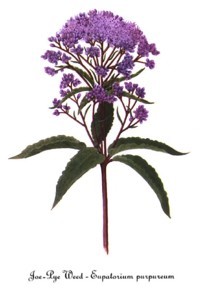Pye in the Sky
By Audrey Stallsmith

I wonder who Joe Pye may be that owns the purple weed.
I've watched it slowly blossom, slowly fade, and go to seed;
But I have had no word or sign that Joe Pye ever came
To see the purple blooming of the plant that bears his name.
"Joe-Pye Weed" by Mrs. Schuyler Van Rensselaer
Joe-Pye weed can loom taller than a man, and was reportedly named for one. According to tradition, Joe Pye was a native American healer who cured typhus with the herb. (Typhus, AKA "jail fever" being a bacterial disease transmitted by lice and fleas, and characterized by dangerously high fevers.)
The "sweet" type of Joe Pye pictured here is called Eupatorium purpureum, for the pink to violet color of its flowers, and smells of vanilla when crushed. The eupatoriums served as the early American "aspirin," especially during flu (and typhus!) epidemics. True boneset, however, rarely surpasses four feet in height. And it sports white rather than purple flowers.
Boneset is officially known as Eupatorium perfoliatum, because its stems appear to perforate its leaves. The plant received its nickname due to its ability to cure "break-bone" or dengue fever, a tropical virus spread by mosquitoes. And the fever doesn't actually break your bones. It just makes you feel as if it has!
Other nicknames for boneset include thoroughwort, ague-weed, crosswort, feverwort, Indian sage, and sweating plant. Many of those monikers allude, of course, to the plants ability to break fevers--especially the achy sort just mentioned.
The eupatoriums were named for Mithridates Eupator, a first century BC king of Pontus who was known for his herbal skillls, as well as his paranoia! Kings of that era generally had good reason to be suspicious of their own families. And legend holds that Eupator originally used some sort of eupatorium to make himself immune to poisons from his mother.
Distrust must have dogged him throughout life, as he eventually had that mother killed, as well as his wife, sons, and an entire harem of concubines. But the immunity he had built up against toxins apparently made it impossible for him to poison himself when he wanted to. So he had to ask one of his own mercenaries to stab him instead! As his story suggests, the eupatoriums can be toxic in large doses, so do be careful when using them.
The plant's bulkier cousin, Joe Pye, has been called purple boneset and gravelweed (for its supposed ability to break up kidney stones). There are several types of similar appearance: purpureum--the "sweet" variety mentioned above, maculatum--the "spotted" version, fistulosum--the "hollow" Joe, and dubium--the "small" one. Most prefer swampy soils, though purpureum's ability to thrive in drier conditions has won it the title Queen of the Meadow.
Although all of these offer many of the same medicinal benefits as their white cousin, herbalists usually harvest the root of Joe Pye, but prefer the leaves of true boneset. Both plants are tonics, painkillers, laxatives, fever-breakers, and expel excess mucous or fluid. But both can also cause vomiting and diarrhea in too-large doses.
So, with aspirin widely available these days, I just enjoy the flowers! There are several garden cultivars now, all attractive to butterflies. I can highly recommend the "chocolate" type I grew one year, even though it turned out to be short-lived.
The term "short-lived" could apply to Eupator's relatives as well. We can conclude from his story that large doses of power can be toxic to a man's soul too. So we'd best not consume too much of that either!
Eupatorium purpureum image is by Mary Vaux Walcott, courtesy of the Southwest School of Botanical Medicine.








